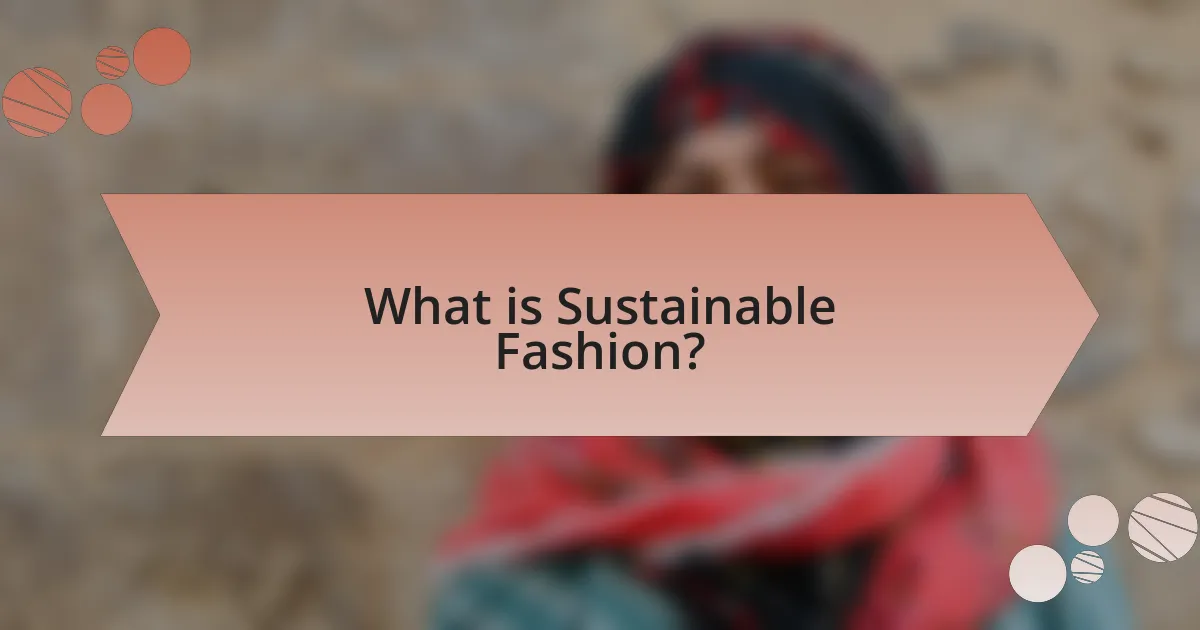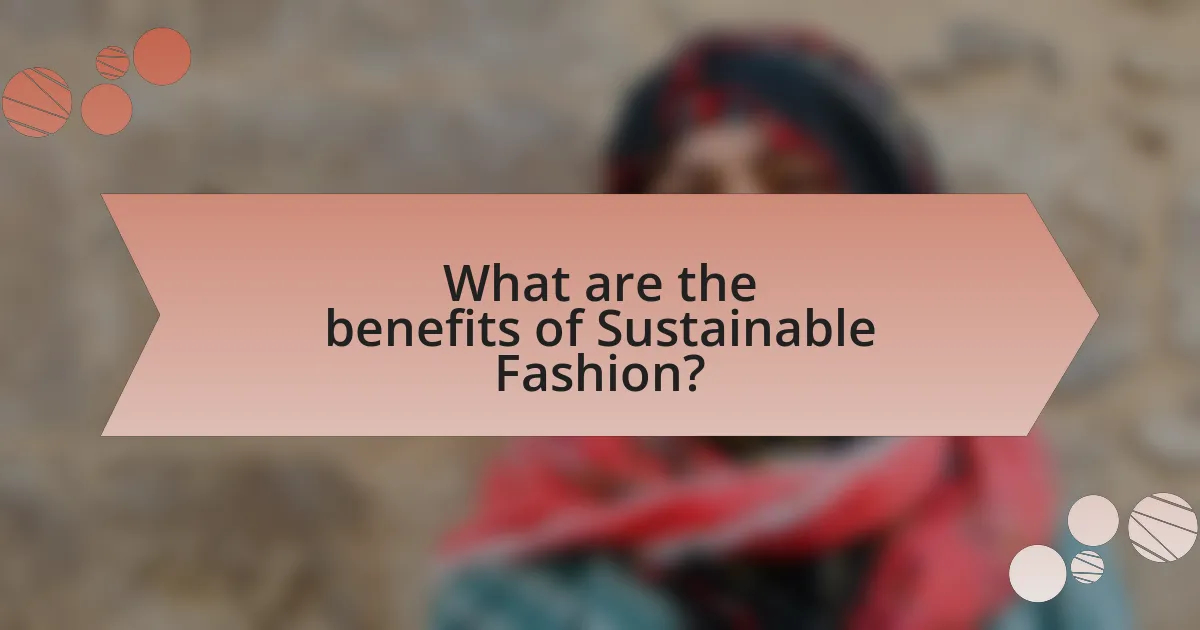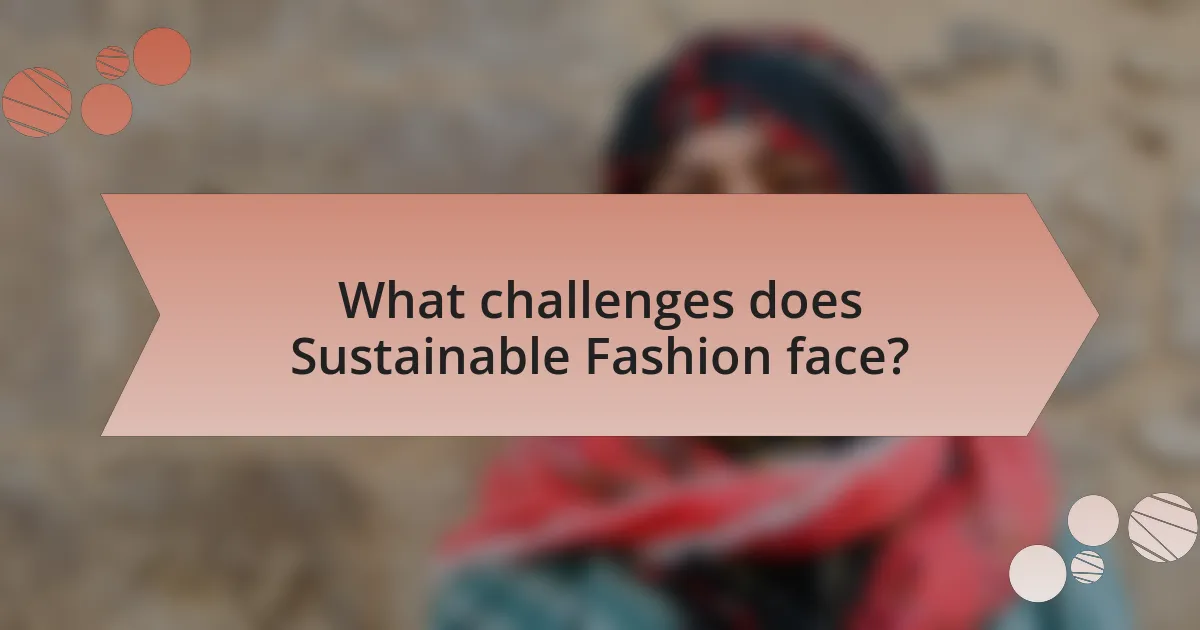Sustainable fashion is defined as clothing and accessories designed, produced, and consumed with minimal environmental impact and a focus on social responsibility. This article explores the differences between sustainable and traditional fashion, emphasizing ethical production, resource efficiency, and circularity. It highlights the importance of eco-friendly materials and ethical labor practices, detailing how individuals can incorporate sustainable choices into their personal style. Additionally, the article addresses the benefits of sustainable fashion for the environment and local economies, the challenges it faces, and practical steps consumers can take to embrace this movement while shopping sustainably on a budget.

What is Sustainable Fashion?
Sustainable fashion refers to clothing and accessories that are designed, produced, and consumed in ways that minimize environmental impact and promote social responsibility. This approach encompasses the use of eco-friendly materials, ethical labor practices, and sustainable production methods, aiming to reduce waste and carbon emissions. According to the Global Fashion Agenda, the fashion industry is responsible for 10% of global carbon emissions, highlighting the urgent need for sustainable practices to mitigate climate change.
How does Sustainable Fashion differ from traditional fashion?
Sustainable fashion differs from traditional fashion primarily in its focus on environmental and social responsibility. While traditional fashion often prioritizes rapid production and consumption, leading to significant waste and exploitation of labor, sustainable fashion emphasizes ethical sourcing, eco-friendly materials, and fair labor practices. For instance, sustainable fashion brands frequently utilize organic cotton or recycled materials, which reduce environmental impact, whereas traditional brands may rely on synthetic fabrics that contribute to pollution. This distinction is supported by the fact that the fashion industry is responsible for approximately 10% of global carbon emissions, highlighting the urgent need for sustainable practices to mitigate climate change.
What are the key principles of Sustainable Fashion?
The key principles of Sustainable Fashion include ethical production, resource efficiency, and circularity. Ethical production emphasizes fair labor practices and transparency in the supply chain, ensuring that workers are treated fairly and compensated adequately. Resource efficiency focuses on minimizing waste and utilizing sustainable materials, such as organic cotton or recycled fabrics, to reduce environmental impact. Circularity promotes the idea of designing products for longevity and recyclability, encouraging consumers to engage in practices like upcycling and responsible disposal. These principles collectively aim to create a fashion industry that respects both people and the planet.
Why is Sustainable Fashion important for the environment?
Sustainable fashion is important for the environment because it reduces waste, conserves resources, and minimizes pollution. The fashion industry is responsible for approximately 10% of global carbon emissions and is a significant contributor to water pollution, with textile dyeing being one of the largest polluters of clean water. By utilizing eco-friendly materials, promoting recycling, and encouraging ethical production practices, sustainable fashion helps to mitigate these environmental impacts. For instance, using organic cotton instead of conventional cotton can reduce water usage by up to 91% and eliminate harmful pesticides, thereby protecting ecosystems and human health.
What are the main components of Sustainable Fashion?
The main components of Sustainable Fashion include ethical sourcing, eco-friendly materials, responsible production processes, and circular economy practices. Ethical sourcing ensures that materials are obtained in a manner that respects labor rights and environmental standards. Eco-friendly materials, such as organic cotton and recycled fabrics, reduce environmental impact. Responsible production processes focus on minimizing waste and energy consumption during manufacturing. Circular economy practices, like recycling and upcycling, extend the lifecycle of garments and reduce landfill waste. These components collectively contribute to a more sustainable fashion industry, addressing both environmental and social concerns.
How do materials impact the sustainability of fashion?
Materials significantly impact the sustainability of fashion by determining the environmental footprint of clothing production and disposal. Sustainable materials, such as organic cotton, Tencel, and recycled polyester, require less water, energy, and chemicals during production compared to conventional materials, thereby reducing pollution and resource depletion. For instance, organic cotton uses 91% less water than conventional cotton, according to the Textile Exchange’s 2021 report. Additionally, the choice of biodegradable or recyclable materials can minimize waste in landfills, as synthetic fibers like polyester can take hundreds of years to decompose. Thus, the selection of materials directly influences the overall sustainability of fashion practices.
What role do ethical labor practices play in Sustainable Fashion?
Ethical labor practices are fundamental to sustainable fashion as they ensure fair treatment, safe working conditions, and equitable wages for workers in the fashion industry. These practices contribute to the overall sustainability of fashion by promoting social responsibility and reducing exploitation, which is essential for creating a more equitable supply chain. For instance, brands that adhere to ethical labor standards often report higher employee satisfaction and lower turnover rates, which can enhance productivity and quality. Furthermore, according to the Ethical Fashion Initiative, ethical labor practices can lead to improved brand loyalty among consumers who prioritize social justice, thereby driving demand for sustainable products.
How can individuals incorporate Sustainable Fashion into their personal style?
Individuals can incorporate Sustainable Fashion into their personal style by choosing clothing made from eco-friendly materials, supporting ethical brands, and embracing second-hand shopping. Eco-friendly materials, such as organic cotton, Tencel, and recycled fabrics, reduce environmental impact and promote sustainability. Supporting ethical brands ensures that workers are treated fairly and that production processes are environmentally responsible. Additionally, second-hand shopping not only extends the life cycle of garments but also reduces waste, as the fashion industry contributes to 92 million tons of textile waste annually. By integrating these practices, individuals can create a personal style that reflects their commitment to sustainability.
What are some eco-friendly brands to consider?
Some eco-friendly brands to consider include Patagonia, Eileen Fisher, and Reformation. Patagonia is known for its commitment to environmental sustainability, using recycled materials and promoting fair labor practices. Eileen Fisher focuses on organic and sustainable fabrics, and has a take-back program for recycling old garments. Reformation emphasizes transparency in its supply chain and uses eco-friendly materials, aiming to reduce its carbon footprint. These brands exemplify sustainable practices in the fashion industry.
How can one build a sustainable wardrobe?
To build a sustainable wardrobe, one should prioritize purchasing high-quality, timeless pieces made from eco-friendly materials. This approach reduces waste and encourages longevity in clothing, as studies show that fast fashion contributes significantly to environmental degradation, with the fashion industry responsible for 10% of global carbon emissions. Additionally, incorporating second-hand clothing and supporting ethical brands further enhances sustainability, as these practices promote circular fashion and reduce the demand for new resources.

What are the benefits of Sustainable Fashion?
Sustainable fashion offers numerous benefits, including reduced environmental impact, ethical labor practices, and enhanced consumer awareness. By utilizing eco-friendly materials and production methods, sustainable fashion significantly lowers carbon emissions and waste, contributing to a healthier planet. For instance, the fashion industry is responsible for approximately 10% of global carbon emissions; sustainable practices can help mitigate this issue. Additionally, sustainable fashion promotes fair labor conditions, ensuring that workers receive fair wages and safe working environments. This ethical approach fosters a more equitable industry. Furthermore, consumers who engage with sustainable fashion often develop a deeper understanding of their purchasing choices, leading to more conscious consumption patterns.
How does Sustainable Fashion contribute to environmental conservation?
Sustainable fashion contributes to environmental conservation by reducing waste and minimizing resource consumption. This approach emphasizes the use of eco-friendly materials, such as organic cotton and recycled fabrics, which require less water and energy to produce compared to conventional textiles. For instance, the production of organic cotton uses 91% less water than traditional cotton farming, significantly lowering the environmental impact. Additionally, sustainable fashion promotes ethical manufacturing practices that reduce pollution and carbon emissions, further aiding in the conservation of ecosystems. By prioritizing durability and timeless design, sustainable fashion also encourages consumers to buy less frequently, thereby decreasing overall textile waste.
What are the long-term benefits of choosing sustainable materials?
Choosing sustainable materials leads to long-term benefits such as reduced environmental impact, improved resource efficiency, and enhanced social responsibility. Sustainable materials, often derived from renewable resources, minimize waste and pollution, contributing to a healthier ecosystem. For instance, using organic cotton instead of conventional cotton reduces water usage by up to 90% and eliminates harmful pesticides, which can harm biodiversity. Additionally, sustainable materials often promote fair labor practices, ensuring that workers receive fair wages and safe working conditions. This approach not only supports ethical production but also fosters consumer trust and brand loyalty, ultimately benefiting businesses in the long run.
How does Sustainable Fashion promote social responsibility?
Sustainable fashion promotes social responsibility by prioritizing ethical labor practices and environmental stewardship. This approach ensures that workers involved in the production process receive fair wages and work in safe conditions, which is supported by organizations like the Ethical Trading Initiative that advocates for workers’ rights. Additionally, sustainable fashion brands often utilize eco-friendly materials and processes, reducing environmental impact and promoting conservation. For instance, a report by the Global Fashion Agenda highlights that sustainable practices can significantly lower carbon emissions and water usage in the fashion industry, thereby contributing to a healthier planet and society.
What economic advantages does Sustainable Fashion offer?
Sustainable fashion offers economic advantages such as cost savings through reduced resource consumption and increased market demand for eco-friendly products. By utilizing sustainable materials and practices, brands can lower production costs associated with waste and energy use. For instance, a study by McKinsey & Company highlights that sustainable practices can lead to a 20-30% reduction in costs for companies that adopt circular economy principles. Additionally, the growing consumer preference for sustainable products has created a lucrative market, with the global sustainable fashion market projected to reach $8.25 billion by 2023, according to a report by Research and Markets. This shift not only enhances brand loyalty but also opens new revenue streams for businesses committed to sustainability.
How can Sustainable Fashion lead to cost savings for consumers?
Sustainable fashion can lead to cost savings for consumers by promoting the purchase of high-quality, durable clothing that lasts longer than fast fashion alternatives. This longevity reduces the frequency of repurchases, ultimately lowering overall spending on clothing. For instance, a study by the Ellen MacArthur Foundation found that extending the life of garments by just nine months can reduce their environmental impact by 20-30% and save consumers money in the long run. Additionally, sustainable fashion often encourages a minimalist wardrobe approach, which focuses on fewer, versatile pieces, further decreasing the need for excessive spending.
What impact does Sustainable Fashion have on local economies?
Sustainable fashion positively impacts local economies by promoting job creation and supporting local artisans. This sector often emphasizes local production, which can lead to increased employment opportunities in communities. For instance, a report by the Ethical Fashion Initiative highlights that sustainable fashion initiatives can create up to 1.5 million jobs in developing countries by 2030, focusing on local craftsmanship and reducing reliance on mass production. Additionally, sustainable fashion encourages consumers to buy locally, which keeps money within the community and stimulates local businesses. This shift not only enhances economic resilience but also fosters a sense of community identity and .

What challenges does Sustainable Fashion face?
Sustainable fashion faces several significant challenges, including high production costs, limited consumer awareness, and supply chain complexities. High production costs arise from the use of eco-friendly materials and ethical labor practices, which can make sustainable garments more expensive than conventional options. Limited consumer awareness hampers the growth of sustainable fashion, as many consumers remain uninformed about the environmental impacts of their clothing choices. Additionally, supply chain complexities complicate the implementation of sustainable practices, as transparency and traceability are often lacking in the fashion industry. These challenges collectively hinder the widespread adoption of sustainable fashion practices.
What are the common misconceptions about Sustainable Fashion?
Common misconceptions about sustainable fashion include the belief that it is always more expensive, that it lacks variety and style, and that it is only about organic materials. Many consumers think sustainable fashion is prohibitively costly; however, studies show that investing in quality, durable clothing can lead to savings over time due to reduced frequency of purchases. Additionally, sustainable fashion encompasses a wide range of styles and designs, debunking the myth that eco-friendly clothing is limited. Lastly, while organic materials are a component, sustainable fashion also involves ethical labor practices, waste reduction, and the use of recycled materials, illustrating that the concept is broader than just fabric choice.
How can misinformation hinder the growth of Sustainable Fashion?
Misinformation can significantly hinder the growth of Sustainable Fashion by creating confusion about what constitutes sustainable practices. For instance, false claims about the environmental impact of certain materials can lead consumers to make uninformed purchasing decisions, ultimately undermining the market for genuinely sustainable products. A study by the Global Fashion Agenda indicates that 75% of consumers are willing to pay more for sustainable products, but misinformation can distort their understanding of what is truly sustainable, leading to skepticism and reduced demand. This confusion can stall the industry’s progress towards more eco-friendly practices and innovations, as brands struggle to communicate their genuine sustainability efforts amidst a backdrop of misleading information.
What are the barriers to accessing sustainable options for consumers?
Barriers to accessing sustainable options for consumers include high costs, limited availability, lack of awareness, and insufficient infrastructure. High costs deter many consumers from purchasing sustainable products, as they often come with a premium price tag compared to conventional options. Limited availability in mainstream retail channels restricts consumer access to eco-friendly choices, making it difficult for individuals to find sustainable alternatives. Additionally, a lack of awareness about the benefits of sustainable fashion and the environmental impact of fast fashion contributes to consumer hesitation. Finally, insufficient infrastructure, such as inadequate recycling systems and limited support for sustainable brands, further complicates the ability of consumers to make eco-friendly choices.
How can the fashion industry overcome these challenges?
The fashion industry can overcome challenges by adopting sustainable practices, such as utilizing eco-friendly materials and implementing circular economy principles. For instance, brands like Stella McCartney have successfully integrated organic cotton and recycled polyester into their collections, reducing environmental impact. Additionally, the industry can enhance transparency in supply chains, as seen in initiatives like the Fashion Transparency Index, which encourages brands to disclose their sourcing and production processes. By prioritizing sustainability and ethical practices, the fashion industry can address environmental concerns while meeting consumer demand for responsible fashion choices.
What role does innovation play in advancing Sustainable Fashion?
Innovation is crucial in advancing Sustainable Fashion by introducing new materials, processes, and technologies that reduce environmental impact. For instance, innovations such as biodegradable fabrics and waterless dyeing techniques significantly lower resource consumption and pollution. According to a report by McKinsey & Company, sustainable innovations can reduce greenhouse gas emissions in the fashion industry by up to 30% by 2030. This demonstrates that innovation not only enhances the sustainability of fashion but also aligns with consumer demand for eco-friendly products.
How can collaboration among brands enhance sustainability efforts?
Collaboration among brands can enhance sustainability efforts by pooling resources, sharing best practices, and creating a unified approach to environmental challenges. When brands collaborate, they can leverage each other’s strengths, such as innovative technologies or sustainable materials, to reduce waste and lower carbon footprints collectively. For instance, the Fashion Pact, which includes major fashion brands, aims to align their sustainability goals, demonstrating that collective action can lead to significant industry-wide changes. This collaboration can also amplify consumer awareness and engagement, as joint initiatives often attract more attention and encourage sustainable consumer behavior.
What practical steps can individuals take to embrace Sustainable Fashion?
Individuals can embrace Sustainable Fashion by making conscious choices in their clothing purchases and care. This includes opting for brands that prioritize ethical production, using sustainable materials, and ensuring fair labor practices. For example, according to the Global Fashion Agenda, the fashion industry is responsible for 10% of global carbon emissions, highlighting the importance of selecting eco-friendly options. Additionally, individuals can extend the life of their garments through proper care, such as washing in cold water and air drying, which reduces energy consumption. Engaging in second-hand shopping and clothing swaps also promotes sustainability by minimizing waste and encouraging a circular economy.
How can one effectively recycle or upcycle clothing?
One can effectively recycle or upcycle clothing by donating, repurposing, or transforming garments into new items. Donating clothing to charities or thrift stores ensures that usable items are given a second life, reducing waste. Repurposing involves creatively altering garments, such as turning old jeans into bags or using fabric scraps for quilts. Transforming clothing can include sewing techniques to create new styles or combining multiple pieces into a single unique item. According to the Ellen MacArthur Foundation, extending the life of clothing by just nine months can reduce carbon, water, and waste footprints by around 20-30%.
What are some tips for shopping sustainably on a budget?
To shop sustainably on a budget, prioritize second-hand shopping, as purchasing used clothing reduces waste and often costs significantly less than new items. Thrift stores, online resale platforms, and clothing swaps are excellent resources for finding affordable, eco-friendly fashion. Additionally, focus on quality over quantity by investing in versatile, durable pieces that will last longer, thereby reducing the need for frequent replacements. Research shows that the fashion industry is responsible for 10% of global carbon emissions, so choosing sustainable brands that prioritize ethical production can also be budget-friendly, especially during sales or with discount codes. Lastly, consider DIY alterations or upcycling old garments to extend their life and reduce waste, which is both cost-effective and environmentally friendly.
